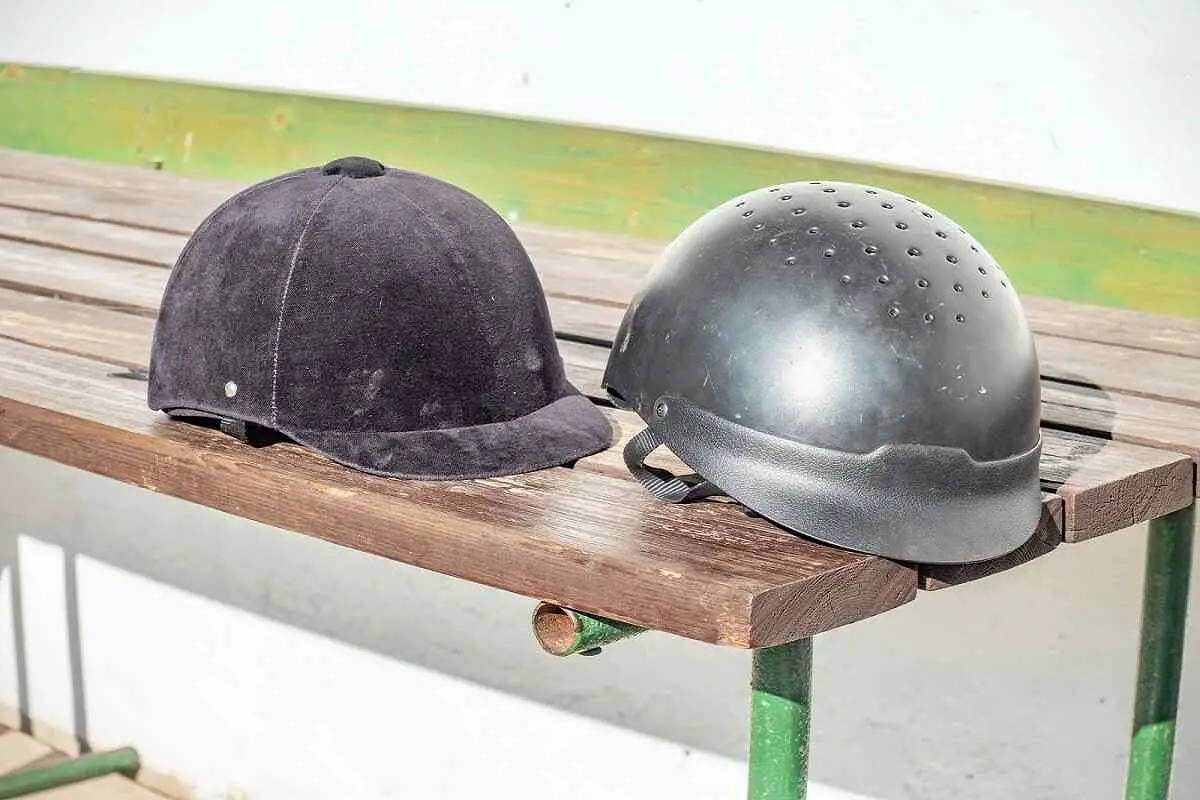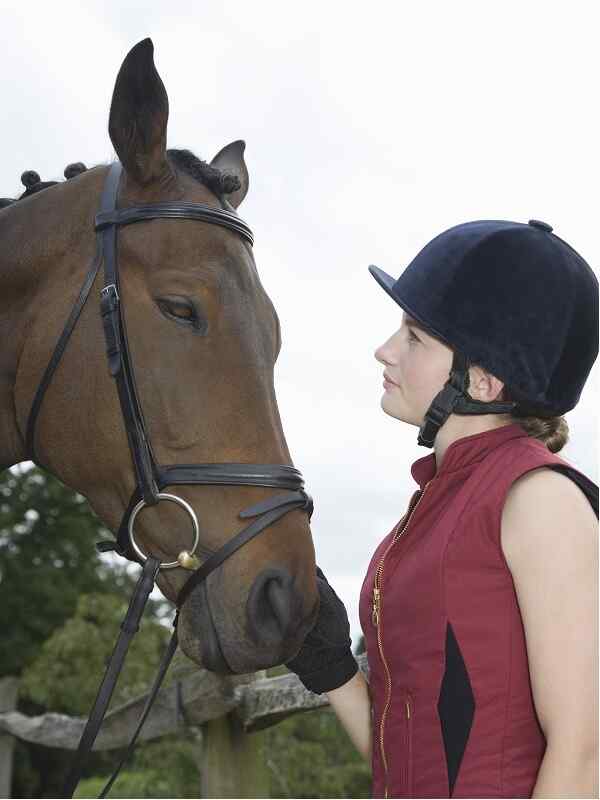What Are Equestrian Helmets Made Of?
As I cast my mind back to the mid-70s, I recall my sister and her horse, Pippin. She would get all dressed up in her riding gear to prepare for her riding lesson.
On top of her head was, what was referred to at the time as, a ‘riding hat’.
And that was basically all it was, just a velvet-covered hat with a chin strap that horse riders wore.
I can’t imagine that it offered much protection, if any, during a fall, but that was part of its purpose apparently. I think its main purpose was just to look like a horse rider.
It wasn’t until the late 1980s that ASTM (American Society for Testing and Materials) developed some certified safety guidelines for riding helmets, with the first certified equestrian helmet released in 1990.
And, while the focus of the modern horse riding helmet is on safety, it is quite apparent that style is also still important, particularly with the more expensive brands.
Page Content

Disclosure: As an Avantlink and Amazon Associate, we earn from qualifying purchases. Disclosure Statement.
What Are Horse Riding Helmets Made Of?
The modern horse riding helmet is composed of the following:
An outer layer – Acrylonitrile Butadiene Styrene (ABS), fiberglass, polycarbonate, carbon fiber or kevlar.
An energy-absorbing inner liner – Expanded PolyStyrene (EPS) or Expanded PolyproPylene (EPP).
Head padding – moisture-wicking polyester and foam.
And a retention strap – leather, suede or nylon.
Even though helmet looks and styles continue to evolve, and the level of safety continues to improve, think MIPS helmets, there are some regular riders way out west that still need some convincing about the need for riding helmets.
SUGGESTED: Horse Riding Helmets For Toddlers
Breakdown Of The Components
The outer layer
The outer layer is the outside shell that everyone can see. It can be shiny or have a matte finish or even have a traditional velvet covering. These days some brands come with a leather, suede or vinyl finish covering the outer layer.
The outer layer is the part that will hit the ground first, so it needs to be very strong and impenetrable as it also needs to withstand a horse’s hoof landing on top of it. For this reason the outer layer is usually made from acrylonitrile butadiene styrene (ABS), fiberglass, polycarbonate, carbon fiber or kevlar.
Some helmets even go so far as to have a lining of both fiberglass and polycarbonate for added strength.
While each material can provide the strong outer layer required, they each have their down-side. For example, fiberglass can splinter, polycarbonate is heavier, carbon fiber is light-weight but expensive and kevlar, which is used for making bulletproof vests is very expensive putting it out of the price range of more than your average horse rider.
The energy-absorbing liner
The energy-absorbing liner is more often than not made from expanded polystyrene (EPS). But, becoming more popular nowadays is expanded polypropylene (EPP).
EPS is the white polystyrene foam that is used for packaging and often used for takeaway food and drinks containers. It has been used as the energy-absorbing liner for a long time, however, the down-side of EPS is that it is a single impact solution. The reason being is that polystyrene will get crushed or squashed on impact, and will not recover or return to its original state. For this reason, helmets must be replaced after a single accident.
This content was originally published on headsdontbounce.com. If it appears on another website, it is a violation of the copyright owned by headsdontbounce.com.
Expanded polypropylene (EPP) is a harder but flexible plastic that can return to its original condition after an impact situation. For this reason, the helmet can be used in multi impacts, thus making it unnecessary to replace the helmet after a single accident.
The head padding
The head padding is the foam and soft material that softly wraps around the shape of your head. It provides the comfort and snugness of the helmet on your head. The material is made of a moisture-wicking polyester to keep the rider’s head dry and comfortable. It is soft, lightweight and durable providing a layer of comfort that allows the helmet to be worn for extended periods of time without burdening the wearer.
RECOMMENDED: Horse Riding Helmets For Kids
The retention straps
Retention straps may also be referred to as chin straps or the harness. The job of the retention strap is to keep the helmet attached to your head during a fall. For this reason, the material used to make a retention strap needs to be strong and durable.
Retention straps at the lower end of the spectrum are often made from nylon with a plastic buckle. The strap may also be covered with a soft padded material to avoid chaffing under the chin area. Better quality retention straps will be made from leather or suede.

A joint effort
All parts of the horse riding helmet are as important as each other part. No part is more important than another.
The outer shell needs to be strong enough to protect your head if it hits the ground, hits a jump or gets stepped on by a shod horse’s hoof.
The inner lining needs to be strong enough to absorb impacts and cushion your head during a fall.
The head padding needs to make the helmet comfortable enough that the rider will be happy to wear the helmet all day long.
The retention straps need to be strong and secure enough that they will never snap or slip during a fall.
Each part works together to complement each other to do the job of protecting your head.
All of the above is held together with glue, rivets, and stitching.
An optional extra
MIPS (Multi-directional Impact Protection System)
The inclusion of MIPS technology into the manufacture of horse riding helmets is not new. In fact, one of the first helmets to be tested with the MIPS technology was a horse riding helmet in 2007. MIPS is designed to address incidents where the heads impacts the ground obliquely causing rotational acceleration to which the brain is very sensitive and can cause a concussion, diffuse axonal injury and subdural hematoma. You can read more about MIPS technology in our article ‘MIPS Helmet Technology‘.
It is interesting to note that tests with bicycle helmets conducted by Virginia Tech have proven conclusively that helmets with MIPS technology are safer than helmets without MIPS technology.
There are now at least 12 equestrian helmet manufacturers that have helmets available with the MIPS protection system built into the helmet.
You can read more about MIPS in equestrian helmets at the MIPS Protection website.
Look for the MIPS logo when buying your helmet.

Whatever you do, don’t forget that heads don’t bounce. Be sure to wear a helmet!
Related Reads:


I have an Ayr8 Plus helmet by Charles Owen and it’s the best I’ve ever owned. Will never buy another brand! Just make sure you get the right size, as the first one I bought from Charles Owen was a bit tight and it took a few weeks to get used to how it fit.
Charles Owen certainly is a great brand. Thanks for your tip, Steve.